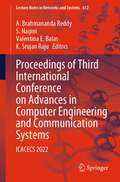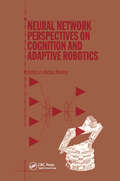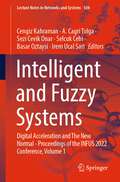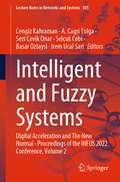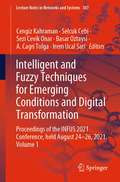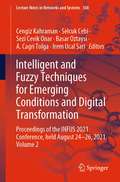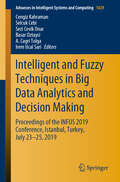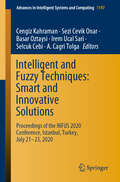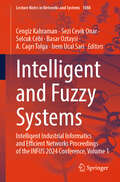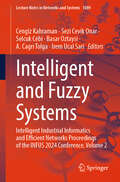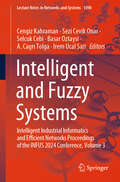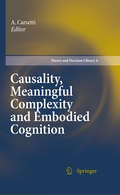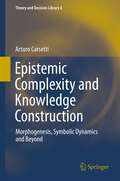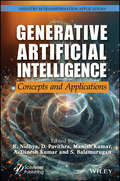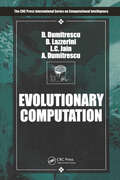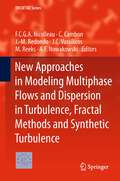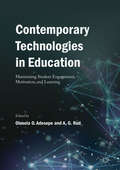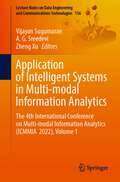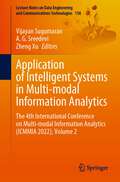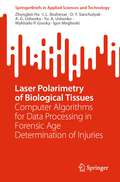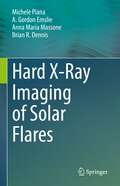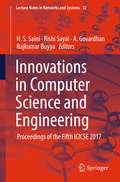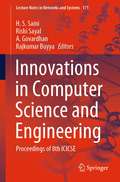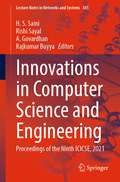- Table View
- List View
Proceedings of Third International Conference on Advances in Computer Engineering and Communication Systems: ICACECS 2022 (Lecture Notes in Networks and Systems #612)
by K. Srujan Raju Valentina E. Balas A. Brahmananda Reddy S. NaginiThis book includes original, peer-reviewed research articles from International Conference on Advances in Computer Engineering and Communication Systems (ICACECS 2022), held in VNR Vignana Jyoythi Institute of Engineering and Technology (VNR VJIET), Hyderabad, Telangana, India, during August 11–12, 2022. The book focuses on “Smart Innovations in Mezzanine Technologies, Data Analytics, Networks and Communication Systems” enlargements and reviews on the advanced topics in artificial intelligence, machine learning, data mining and big data computing, knowledge engineering, semantic Web, cloud computing, Internet of Things, cybersecurity, communication systems, and distributed computing and smart systems.
Neural Network Perspectives on Cognition and Adaptive Robotics
by A. BrowneFeaturing an international team of authors, Neural Network Perspectives on Cognition and Adaptive Robotics presents several approaches to the modeling of human cognition and language using neural computing techniques. It also describes how adaptive robotic systems can be produced using neural network architectures. Covering a wide range of mainstream area and trends, each chapter provides the latest information from a different perspective.
The Art Of Going Viral: 17 Studies To Reach Millions, Gain Influence, And Get Internet Famous
by A. C. ClintWhy is it that some things EXPLODE online, while others linger in anonymity for years? Why do some things hook our attention, while others flop? Is there a pattern behind how social media captivates us? Viral fame is not just a coincidence. There is an easy-to-learn strategy behind it. Whether your dream is YouTube stardom, or just creating opportunity with a personal brand, Going Viral is your blueprint for digital success. Stand out, get noticed, and captivate online. Going Viral pairs raw human behavioral data with the emotional intelligence of A.C. Clint, a sought-after digital media coach who has worked with Fortune 500 clients from Disney to Nike. Clint has distilled years of research and practical experience to write this manual for content people are wired to share.
Intelligent and Fuzzy Systems: Digital Acceleration and The New Normal - Proceedings of the INFUS 2022 Conference, Volume 1 (Lecture Notes in Networks and Systems #504)
by Cengiz Kahraman Selcuk Cebi Sezi Cevik Onar Basar Oztaysi A. Cagri Tolga Irem Ucal SariThis book presents recent research in intelligent and fuzzy techniques on digital transformation and the new normal, the state to which economies, societies, etc. settle following a crisis bringing us to a new environment. Digital transformation and the new normal-appearing in many areas such as digital economy, digital finance, digital government, digital health, and digital education are the main scope of this book. The readers can benefit from this book for preparing for a digital “new normal” and maintaining a leadership position among competitors in both manufacturing and service companies. Digitizing an industrial company is a challenging process, which involves rethinking established structures, processes, and steering mechanisms presented in this book. The intended readers are intelligent and fuzzy systems researchers, lecturers, M.Sc., and Ph.D. students studying digital transformation and new normal. The book covers fuzzy logic theory and applications, heuristics, and metaheuristics from optimization to machine learning, from quality management to risk management, making the book an excellent source for researchers.
Intelligent and Fuzzy Systems: Digital Acceleration and The New Normal - Proceedings of the INFUS 2022 Conference, Volume 2 (Lecture Notes in Networks and Systems #505)
by Cengiz Kahraman Selcuk Cebi Sezi Cevik Onar Basar Oztaysi A. Cagri Tolga Irem Ucal SariThis book presents recent research in intelligent and fuzzy techniques on digital transformation and the new normal, the state to which economies, societies, etc. settle following a crisis bringing us to a new environment. Digital transformation and the new normal-appearing in many areas such as digital economy, digital finance, digital government, digital health, and digital education are the main scope of this book. The readers can benefit from this book for preparing for a digital “new normal” and maintaining a leadership position among competitors in both manufacturing and service companies. Digitizing an industrial company is a challenging process, which involves rethinking established structures, processes, and steering mechanisms presented in this book. The intended readers are intelligent and fuzzy systems researchers, lecturers, M.Sc., and Ph.D. students studying digital transformation and new normal. The book covers fuzzy logic theory and applications, heuristics, and metaheuristics from optimization to machine learning, from quality management to risk management, making the book an excellent source for researchers.
Intelligent and Fuzzy Techniques for Emerging Conditions and Digital Transformation: Proceedings of the INFUS 2021 Conference, held August 24-26, 2021. Volume 1 (Lecture Notes in Networks and Systems #307)
by Cengiz Kahraman Selcuk Cebi Sezi Cevik Onar Basar Oztaysi A. Cagri Tolga Irem Ucal SariThis book presents recent research in intelligent and fuzzy techniques. Emerging conditions such as pandemic, wars, natural disasters and various high technologies force people for significant changes in business and social life. The adoption of digital technologies to transform services or businesses, through replacing non-digital or manual processes with digital processes or replacing older digital technology with newer digital technologies through intelligent systems is the main scope of this book. It focuses on revealing the reflection of digital transformation in our business and social life under emerging conditions through intelligent and fuzzy systems. The latest intelligent and fuzzy methods and techniques on digital transformation are introduced by theory and applications. The intended readers are intelligent and fuzzy systems researchers, lecturers, M.Sc. and Ph.D. students studying digital transformation. Usage of ordinary fuzzy sets and their extensions, heuristics and metaheuristics from optimization to machine learning, from quality management to risk management makes the book an excellent source for researchers.
Intelligent and Fuzzy Techniques for Emerging Conditions and Digital Transformation: Proceedings of the INFUS 2021 Conference, held August 24-26, 2021. Volume 2 (Lecture Notes in Networks and Systems #308)
by Cengiz Kahraman Selcuk Cebi Sezi Cevik Onar Basar Oztaysi A. Cagri Tolga Irem Ucal SariThis book presents recent research in intelligent and fuzzy techniques. Emerging conditions such as pandemic, wars, natural disasters and various high technologies force people for significant changes in business and social life. The adoption of digital technologies to transform services or businesses, through replacing non-digital or manual processes with digital processes or replacing older digital technology with newer digital technologies through intelligent systems is the main scope of this book. It focuses on revealing the reflection of digital transformation in our business and social life under emerging conditions through intelligent and fuzzy systems. The latest intelligent and fuzzy methods and techniques on digital transformation are introduced by theory and applications. The intended readers are intelligent and fuzzy systems researchers, lecturers, M.Sc. and Ph.D. students studying digital transformation. Usage of ordinary fuzzy sets and their extensions, heuristics and metaheuristics from optimization to machine learning, from quality management to risk management makes the book an excellent source for researchers.
Intelligent and Fuzzy Techniques in Big Data Analytics and Decision Making: Proceedings of the INFUS 2019 Conference, Istanbul, Turkey, July 23-25, 2019 (Advances in Intelligent Systems and Computing #1029)
by Cengiz Kahraman Selcuk Cebi Sezi Cevik Onar Basar Oztaysi A. Cagri Tolga Irem Ucal SariThis book includes the proceedings of the Intelligent and Fuzzy Techniques INFUS 2019 Conference, held in Istanbul, Turkey, on July 23–25, 2019. Big data analytics refers to the strategy of analyzing large volumes of data, or big data, gathered from a wide variety of sources, including social networks, videos, digital images, sensors, and sales transaction records. Big data analytics allows data scientists and various other users to evaluate large volumes of transaction data and other data sources that traditional business systems would be unable to tackle. Data-driven and knowledge-driven approaches and techniques have been widely used in intelligent decision-making, and they are increasingly attracting attention due to their importance and effectiveness in addressing uncertainty and incompleteness. INFUS 2019 focused on intelligent and fuzzy systems with applications in big data analytics and decision-making, providing an international forum that brought together those actively involved in areas of interest to data science and knowledge engineering. These proceeding feature about 150 peer-reviewed papers from countries such as China, Iran, Turkey, Malaysia, India, USA, Spain, France, Poland, Mexico, Bulgaria, Algeria, Pakistan, Australia, Lebanon, and Czech Republic.
Intelligent and Fuzzy Techniques: Proceedings of the INFUS 2020 Conference, Istanbul, Turkey, July 21-23, 2020 (Advances in Intelligent Systems and Computing #1197)
by Cengiz Kahraman Selcuk Cebi Sezi Cevik Onar Basar Oztaysi A. Cagri Tolga Irem Ucal SariThis book gathers the most recent developments in fuzzy & intelligence systems and real complex systems presented at INFUS 2020, held in Istanbul on July 21–23, 2020. The INFUS conferences are a well-established international research forum to advance the foundations and applications of intelligent and fuzzy systems, computational intelligence, and soft computing, highlighting studies on fuzzy & intelligence systems and real complex systems at universities and international research institutions. Covering a range of topics, including the theory and applications of fuzzy set extensions such as intuitionistic fuzzy sets, hesitant fuzzy sets, spherical fuzzy sets, and fuzzy decision-making; machine learning; risk assessment; heuristics; and clustering, the book is a valuable resource for academics, M.Sc. and Ph.D. students, as well as managers and engineers in industry and the service sectors.
Intelligent and Fuzzy Systems: Intelligent Industrial Informatics and Efficient Networks Proceedings of the INFUS 2024 Conference, Volume 1 (Lecture Notes in Networks and Systems #1088)
by Cengiz Kahraman Selcuk Cebi Sezi Cevik Onar Basar Oztaysi Irem Ucal Sari A. Cagrı TolgaThis book presents recent research in intelligent and fuzzy techniques on Intelligent Industrial Informatics and Efficient Networks. This cutting-edge field integrates advanced technologies, such as artificial intelligence, machine learning and data analytics, into industrial processes, revolutionizing the way industries operate. The book presents the examples of the implementation of smart sensors and IoT devices, which facilitate real-time data collection and communication. High-speed, low-latency networks ensure that information flows effortlessly between devices, enabling timely responses and enabling the coordination of complex manufacturing processes. This network architecture supports the integration of edge computing, where data processing occurs closer to the source, reducing latency and enabling faster decision-making. The readers can benefit from this book for maintaining a leadership position among competitors in both manufacturing and service companies. The intended readers are intelligent and fuzzy systems researchers, lecturers, M.Sc. and Ph.D. students studying intelligent and fuzzy techniques. The book covers fuzzy logic theory and applications, heuristics and metaheuristics from optimization to machine learning, from quality management to risk management, making the book an excellent source for researchers.
Intelligent and Fuzzy Systems: Intelligent Industrial Informatics and Efficient Networks Proceedings of the INFUS 2024 Conference, Volume 2 (Lecture Notes in Networks and Systems #1089)
by Cengiz Kahraman Selcuk Cebi Sezi Cevik Onar Basar Oztaysi Irem Ucal Sari A. Cagrı TolgaThis book presents recent research in intelligent and fuzzy techniques on Intelligent Industrial Informatics and Efficient Networks. This cutting-edge field integrates advanced technologies, such as artificial intelligence, machine learning and data analytics, into industrial processes, revolutionizing the way industries operate. The book presents the examples of the implementation of smart sensors and IoT devices, which facilitate real-time data collection and communication. High-speed, low-latency networks ensure that information flows effortlessly between devices, enabling timely responses and enabling the coordination of complex manufacturing processes. This network architecture supports the integration of edge computing, where data processing occurs closer to the source, reducing latency and enabling faster decision-making. The readers can benefit from this book for maintaining a leadership position among competitors in both manufacturing and service companies. The intended readers are intelligent and fuzzy systems researchers, lecturers, M.Sc. and Ph.D. students studying intelligent and fuzzy techniques. The book covers fuzzy logic theory and applications, heuristics and metaheuristics from optimization to machine learning, from quality management to risk management, making the book an excellent source for researchers.
Intelligent and Fuzzy Systems: Intelligent Industrial Informatics and Efficient Networks Proceedings of the INFUS 2024 Conference, Volume 3 (Lecture Notes in Networks and Systems #1090)
by Cengiz Kahraman Selcuk Cebi Sezi Cevik Onar Basar Oztaysi Irem Ucal Sari A. Cagrı TolgaThis book presents recent research in intelligent and fuzzy techniques on Intelligent Industrial Informatics and Efficient Networks. This cutting-edge field integrates advanced technologies, such as artificial intelligence, machine learning and data analytics, into industrial processes, revolutionizing the way industries operate. The book presents the examples of the implementation of smart sensors and IoT devices, which facilitate real-time data collection and communication. High-speed, low-latency networks ensure that information flows effortlessly between devices, enabling timely responses and enabling the coordination of complex manufacturing processes. This network architecture supports the integration of edge computing, where data processing occurs closer to the source, reducing latency and enabling faster decision-making. The readers can benefit from this book for maintaining a leadership position among competitors in both manufacturing and service companies. The intended readers are intelligent and fuzzy systems researchers, lecturers, M.Sc. and Ph.D. students studying intelligent and fuzzy techniques. The book covers fuzzy logic theory and applications, heuristics and metaheuristics from optimization to machine learning, from quality management to risk management, making the book an excellent source for researchers.
Causality, Meaningful Complexity and Embodied Cognition (Theory and Decision Library A: #46)
by A. CarsettiWith respect to the possible outlining of new models of the process of knowledge construction, we are really faced, at the moment, with the appearance of a new frontier: a frontier that appears strictly linked to the emergence of a conceptual revolution at the level of the analysis of that peculiar entanglement of complexity, information, causality, meaning, emergence, teleology and intentionality that characterizes the unfolding of the "natural forms" of human cognition. To recognize some of the peculiar knots of this particular conceptual revolution precisely constitutes the first target of the volume. Cognitive activity is rooted in Reality, but at the same time represents the necessary means whereby Reality can embody itself in an objective way: i.e., in accordance with an in-depth nesting process and a surface unfolding of operational meaning. In this sense, the objectivity of Reality is also proportionate to the autonomy reached by cognitive processes. Within this conceptual framework, reference procedures thus appear as related to the modalities providing the successful constitution of the channel, of the actual link, in particular, established at the neural level between operations of vision and thought. Such procedures ensure not a simple "regimentation" or an adequate replica, but, on the contrary, the real constitution of a cognitive autonomy in accordance with the truth. A method thus emerges which is simultaneously project, telos and regulating activity: a code that becomes process, positing itself as the foundation of a constantly renewed synthesis between function and meaning. In this sense, at the level of cultural evolution, reference procedures act as guide, mirror and canalisation with respect to primary information flows and involved selective forces. They also constitute a precise support for the operations which "imprison" meaning and "inscribe" the "file" considered as an autonomous categorial (and generating) system. In this way, they offer themselves as the actual instruments for the constant renewal of the code, for the invention and the actual articulation of an ever-new incompressibility.
Epistemic Complexity and Knowledge Construction
by A. CarsettiThe volume as its first target aims at clarifying that peculiar entanglement of complexity, causality, meaning, emergence and intentionality that characterises the unfolding of the "natural forms" of human cognition As is well known, cognition is not only a self-organising process. It is also a co-operative and coupled process. If we consider the external environment as a complex, multiple and stratified Source which interacts with the nervous system, we can easily realise that the cognitive activities devoted to the "intelligent" search for the depth information living in the Source, may determine the very change of the complexity conditions according to which the Source progressively expresses its "wild" action. In this sense, simulation models are not neutral or purely speculative: the true cognition actually appears to be necessarily connected with successful forms of reading, those forms, in particular, that permit a specific coherent unfolding of the deep information content of the Source. Therefore, the simulation models, if valid, materialise as "creative" channels, i.e., as autonomous functional systems, as the very roots of a new possible development of the entire system represented by mind and its Reality. From a general point of view, the objectivity of Reality is also proportionate to the autonomy reached by cognitive processes. In this sense, at the level of cultural evolution, reference procedures act as guide, mirror and canalisation with respect to primary information flows and involved selective forces: they offer themselves as the actual instruments for the constant renewal of the code, for the invention and the actual articulation of an ever-new incompressibility. From an effective point of view, they appear as indissolubly linked to the successive definition of specific (and innovative) measures of the epistemic complexity. These measures cannot concern only statistical rarity (Shannon) or computational incompressibility (Kolmogorov-Chaitin), on the contrary they should also be able to take into account the coupled connection between the Source and the cognitive agent, the evolution of this connection as well as the successive constitution of meaning as symbolic form. Hence the possible (and necessary) definition of new axiomatic systems, new measure spaces, the real displaying of processes of continuous reorganisation at the semantic level. Indeed, it is only through a complete, first-order "reduction" and a correlated non-standard second-order analysis that new incompressibility will actually manifest itself. Therefore, the reference procedures appear to be related to a process of multiplication of minds, as well as to a process of "clarification" of meanings which finally emerges as vision via principles.
Generative Artificial Intelligence: Concepts and Applications (Industry 5.0 Transformation Applications)
by Manish Kumar S. Balamurugan R. Nidhya D. Pavithra A. Dinesh KumarThis book is a comprehensive overview of AI fundamentals and applications to drive creativity, innovation, and industry transformation. Generative AI stands at the forefront of artificial intelligence innovation, redefining the capabilities of machines to create, imagine, and innovate. GAI explores the domain of creative production with new and original content across various forms, including images, text, music, and more. In essence, generative AI stands as evidence of the boundless potential of artificial intelligence, transforming industries, sparking creativity, and challenging conventional paradigms. It represents not just a technological advancement but a catalyst for reimagining how machines and humans collaborate, innovate, and shape the future. The book examines real-world examples of how generative AI is being used in a variety of industries. The first section explores the fundamental concepts and ethical considerations of generative AI. In addition, the section also introduces machine learning algorithms and natural language processing. The second section introduces novel neural network designs and convolutional neural networks, providing dependable and precise methods. The third section explores the latest learning-based methodologies to help researchers and farmers choose optimal algorithms for specific crop and hardware needs. Furthermore, this section evaluates significant advancements in revolutionizing online content analysis, offering real-time insights into content creation for more interactive processes. Audience The book will be read by researchers, engineers, and students working in artificial intelligence, computer science, and electronics and communication engineering as well as industry application areas.
Evolutionary Computation (International Series on Computational Intelligence)
by D. Dumitrescu Beatrice Lazzerini Lakhmi C. Jain A. DumitrescuRapid advances in evolutionary computation have opened up a world of applications-a world rapidly growing and evolving. Decision making, neural networks, pattern recognition, complex optimization/search tasks, scheduling, control, automated programming, and cellular automata applications all rely on evolutionary computation. Evolutionary Com
New Approaches in Modeling Multiphase Flows and Dispersion in Turbulence, Fractal Methods and Synthetic Turbulence
by J. M. Redondo A. F. Nowakowski C. Cambon F.C.G.A. Nicolleau J. C. Vassilicos M. ReeksThis book contains a collection of the main contributions from the first five workshops held by Ercoftac Special Interest Group on Synthetic Turbulence Models (SIG42. It is intended as an illustration of the sig's activities and of the latest developments in the field. This volume investigates the use of Kinematic Simulation (KS) and other synthetic turbulence models for the particular application to environmental flows. This volume offers the best syntheses on the research status in KS, which is widely used in various domains, including Lagrangian aspects in turbulence mixing/stirring, particle dispersion/clustering, and last but not least, aeroacoustics. Flow realizations with complete spatial, and sometime spatio-temporal, dependency, are generated via superposition of random modes (mostly spatial, and sometime spatial and temporal, Fourier modes), with prescribed constraints such as: strict incompressibility (divergence-free velocity field at each point), high Reynolds energy spectrum. Recent improvements consisted in incorporating linear dynamics, for instance in rotating and/or stably-stratified flows, with possible easy generalization to MHD flows, and perhaps to plasmas. KS for channel flows have also been validated. However, the absence of "sweeping effects" in present conventional KS versions is identified as a major drawback in very different applications: inertial particle clustering as well as in aeroacoustics. Nevertheless, this issue was addressed in some reference papers, and merits to be revisited in the light of new studies in progress.
Contemporary Technologies in Education: Maximizing Student Engagement, Motivation, and Learning
by A. G. Rud Olusola O. AdesopeThis edited volume provides a critical discussion of theoretical, methodological, and practical developments of contemporary forms of educational technologies. Specifically, the book discusses the use of contemporary technologies such as the Flipped Classroom (FC), Massive Open Online Course (MOOC), Social Media, Serious Educational Games (SEG), Wikis, innovative learning software tools, and learning analytic approach for making sense of big data. While some of these contemporary educational technologies have been touted as panaceas, researchers and developers have been faced with enormous challenges in enhancing the use of these technologies to arouse student attention and improve persistent motivation, engagement, and learning. Hence, the book examines how contemporary technologies can engender student motivation and result in improved engagement and learning. Each chapter also discusses the road ahead and where appropriate, uses the current trend to predict future affordances of technologies.
Application of Intelligent Systems in Multi-modal Information Analytics: The 4th International Conference on Multi-modal Information Analytics (ICMMIA 2022), Volume 1 (Lecture Notes on Data Engineering and Communications Technologies #136)
by Vijayan Sugumaran Zheng Xu A. G. SreedeviThis book provides comprehensive coverage of the latest advances and trends in information technology, science, and engineering. Specifically, it addresses a number of broad themes, including multimodal informatics, data mining, agent-based and multi-agent systems for health and education informatics, which inspire the development of intelligent information technologies. The contributions cover a wide range of topics such as AI applications and innovations in health and education informatics; data and knowledge management; multimodal application management; and web/social media mining for multimodal informatics. Outlining promising future research directions, the book is a valuable resource for students, researchers, and professionals and a useful reference guide for newcomers to the field. This book is a compilation of the papers presented in the 4th International Conference on Multi-modal Information Analytics, held online, on April 23, 2022.
Application of Intelligent Systems in Multi-modal Information Analytics: The 4th International Conference on Multi-modal Information Analytics (ICMMIA 2022), Volume 2 (Lecture Notes on Data Engineering and Communications Technologies #138)
by Vijayan Sugumaran Zheng Xu A. G. SreedeviThis book provides comprehensive coverage of the latest advances and trends in information technology, science and engineering. Specifically, it addresses a number of broad themes, including multi-modal informatics, data mining, agent-based and multi-agent systems for health and education informatics, which inspire the development of intelligent information technologies. The book covers a wide range of topics such as AI applications and innovations in health and education informatics; data and knowledge management; multi-modal application management; and web/social media mining for multi-modal informatics. Outlining promising future research directions, the book is a valuable resource for students, researchers and professionals and a useful reference guide for newcomers to the field. This book is a compilation of the papers presented in the 4th International Conference on Multi-modal Information Analytics, held online, on April 23, 2022.
Laser Polarimetry of Biological Tissues: Computer Algorithms for Data Processing in Forensic Age Determination of Injuries (SpringerBriefs in Applied Sciences and Technology)
by A. G. Ushenko Yu. A. Ushenko Igor Meglinski Zhengbin Hu I.L. Bezhenar O.Y. Vanchulyak Mykhailo P. GorskyThis book highlights the results of numerical computer-aided smart methods as part of a comprehensive statistical, correlated, and fractal analysis of laser polarimetry. It includes a comprehensive approach to differentiation of lifelong or postmortem origin of injuries and determination of their antiquity based on the analysis of statistical and spatiotemporal frequency evolution of photometric, polarization, and phase parameters of laser images of histological sections of the skin of biomannequins. It discusses the relationship between the coordinate distributions of the intensity of laser images from skin tissues of biomannequins and the nature of its damage. It presents the analysis of relationships between changes in the mean and variance of coordinate distributions of azimuths and ellipticity of polarization images of histological skin sections and the time intervals after injury. Complex differentiation of lifelong and postmortem skin injuries of biomannequins and establishment of their time intervals throughout the entire monitoring interval of changes in the mean and variance of coordinate distributions of phase shifts between orthogonal components of the amplitude of laser images of a series of corresponding histological sections are also presented in this book.
Hard X-Ray Imaging of Solar Flares
by Michele Piana A. Gordon Emslie Anna Maria Massone Brian R. DennisThe idea for this text emerged over several years as the authors participated in research projects related to analysis of data from NASA's RHESSI Small Explorer mission. The data produced over the operational lifetime of this mission inspired many investigations related to a specific science question: the when, where, and how of electron acceleration during solar flares in the stressed magnetic environment of the active Sun.A vital key to unlocking this science problem is the ability to produce high-quality images of hard X-rays produced by bremsstrahlung radiation from electrons accelerated during a solar flare. The only practical way to do this within the technological and budgetary limitations of the RHESSI era was to opt for indirect modalities in which imaging information is encoded as a set of two-dimensional spatial Fourier components. Radio astronomers had employed Fourier imaging for many years. However, differently than for radio astronomy, X-ray images produced by RHESSI had to be constructed from a very limited number of sparsely distributed and very noisy Fourier components. Further, Fourier imaging is hardly intuitive, and extensive validation of the methods was necessary to ensure that they produced images with sufficient accuracy and fidelity for scientific applications.This book summarizes the results of this development of imaging techniques specifically designed for this form of data. It covers a set of published works that span over two decades, during which various imaging methods were introduced, validated, and applied to observations. Also considering that a new Fourier-based telescope, STIX, is now entering its nominal phase on-board the ESA Solar Orbiter, it became more and more apparent to the authors that it would be a good idea to put together a compendium of these imaging methods and their applications. Hence the book you are now reading.
Innovations in Computer Science and Engineering: Proceedings Of The Third Icicse 2015 (Advances In Intelligent Systems And Computing #413)
by Rajkumar Buyya H. S. Saini Rishi Sayal A. GovardhanThe book is a collection of high-quality peer-reviewed research papers presented at the Fifth International Conference on Innovations in Computer Science and Engineering (ICICSE 2017) held at Guru Nanak Institutions, Hyderabad, India during 18-19 August 2017. The book discusses a wide variety of industrial, engineering and scientific applications of the engineering techniques. Researchers from academic and industry present their original work and exchange ideas, information, techniques and applications in the field of Communication, Computing and Data Science and Analytics.
Innovations in Computer Science and Engineering: Proceedings of 8th ICICSE (Lecture Notes in Networks and Systems #171)
by Rajkumar Buyya H. S. Saini Rishi Sayal A. GovardhanThis book features a collection of high-quality, peer-reviewed research papers presented at the 8th International Conference on Innovations in Computer Science & Engineering (ICICSE 2020), held at Guru Nanak Institutions, Hyderabad, India, on 28–29 August 2020. It covers the latest research in data science and analytics, cloud computing, machine learning, data mining, big data and analytics, information security and privacy, wireless and sensor networks and IoT applications, artificial intelligence, expert systems, natural language processing, image processing, computer vision and artificial neural networks.
Innovations in Computer Science and Engineering: Proceedings of the Ninth ICICSE, 2021 (Lecture Notes in Networks and Systems #385)
by Rajkumar Buyya H. S. Saini Rishi Sayal A. GovardhanThis book features a collection of high-quality, peer-reviewed research papers presented at the 9th International Conference on Innovations in Computer Science & Engineering (ICICSE 2021), held at Guru Nanak Institutions, Hyderabad, India, on September 3–4, 2021. It covers the latest research in data science and analytics, cloud computing, machine learning, data mining, big data and analytics, information security and privacy, wireless and sensor networks and IoT applications, artificial intelligence, expert systems, natural language processing, image processing, computer vision, and artificial neural networks.
